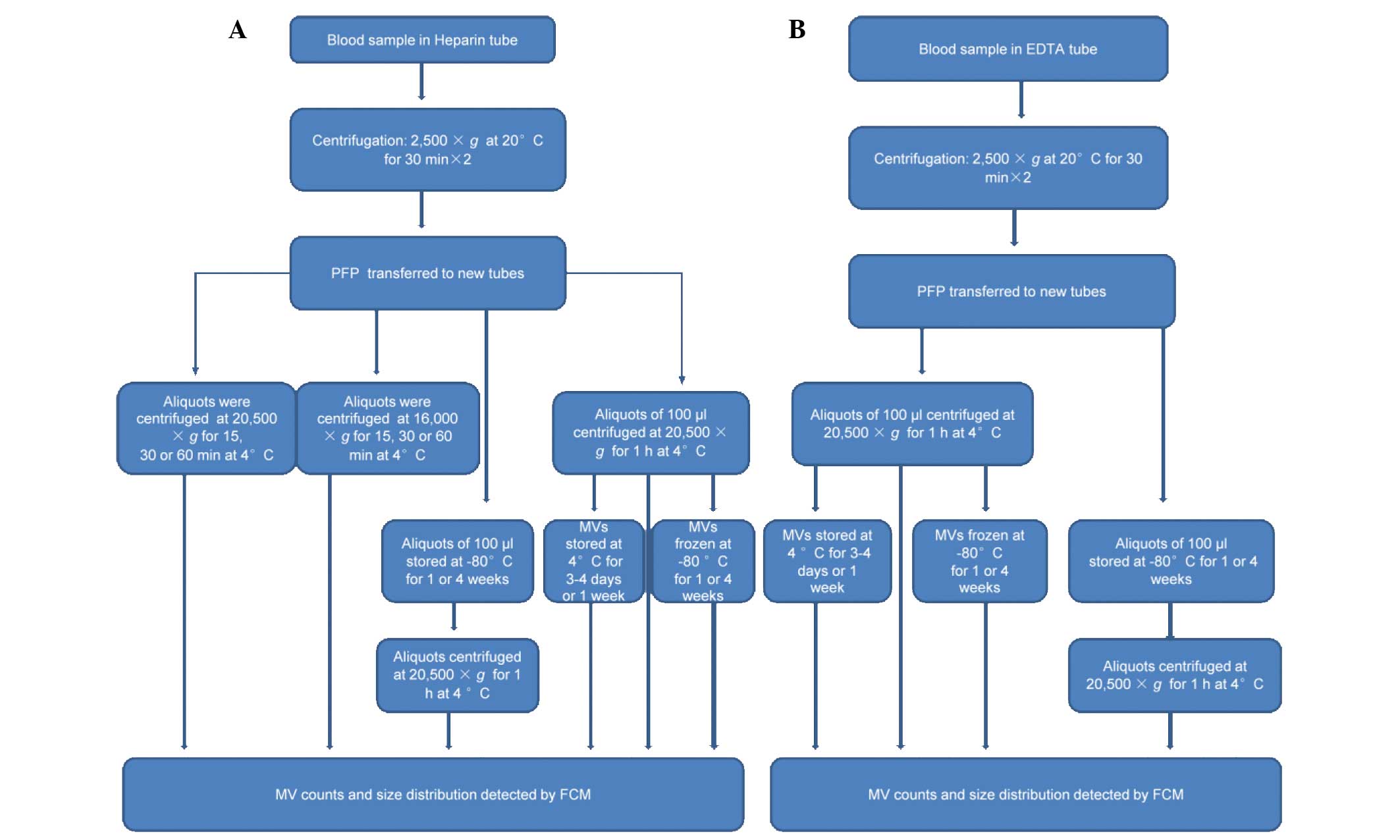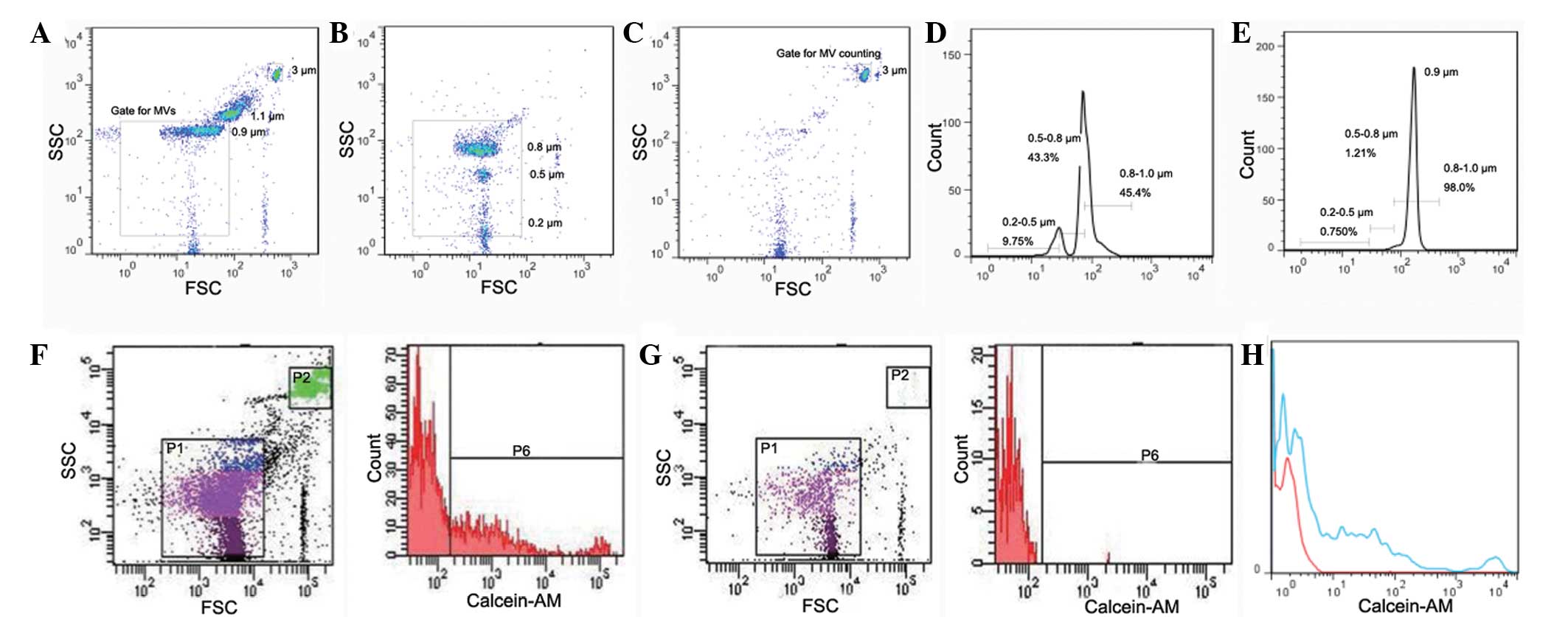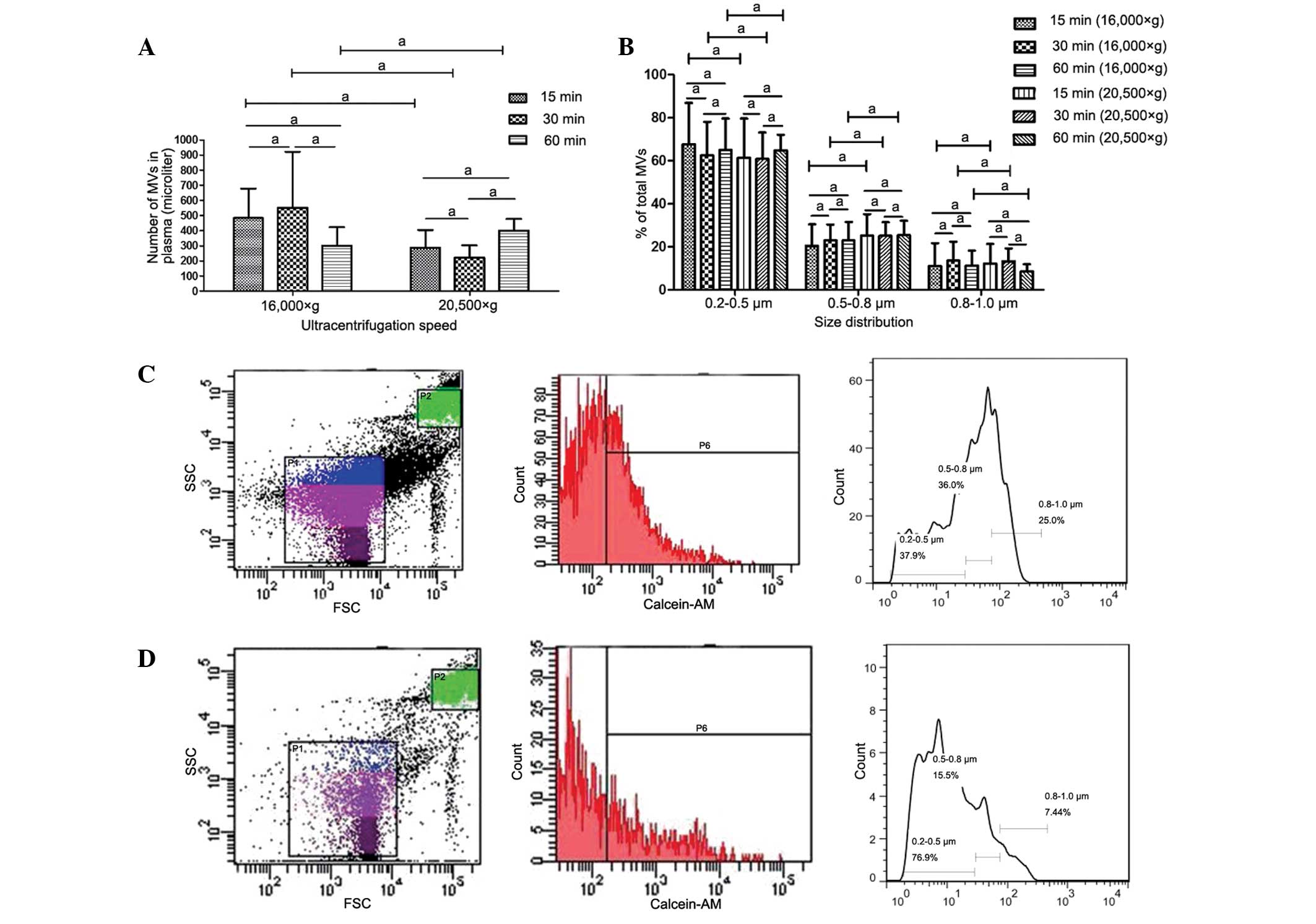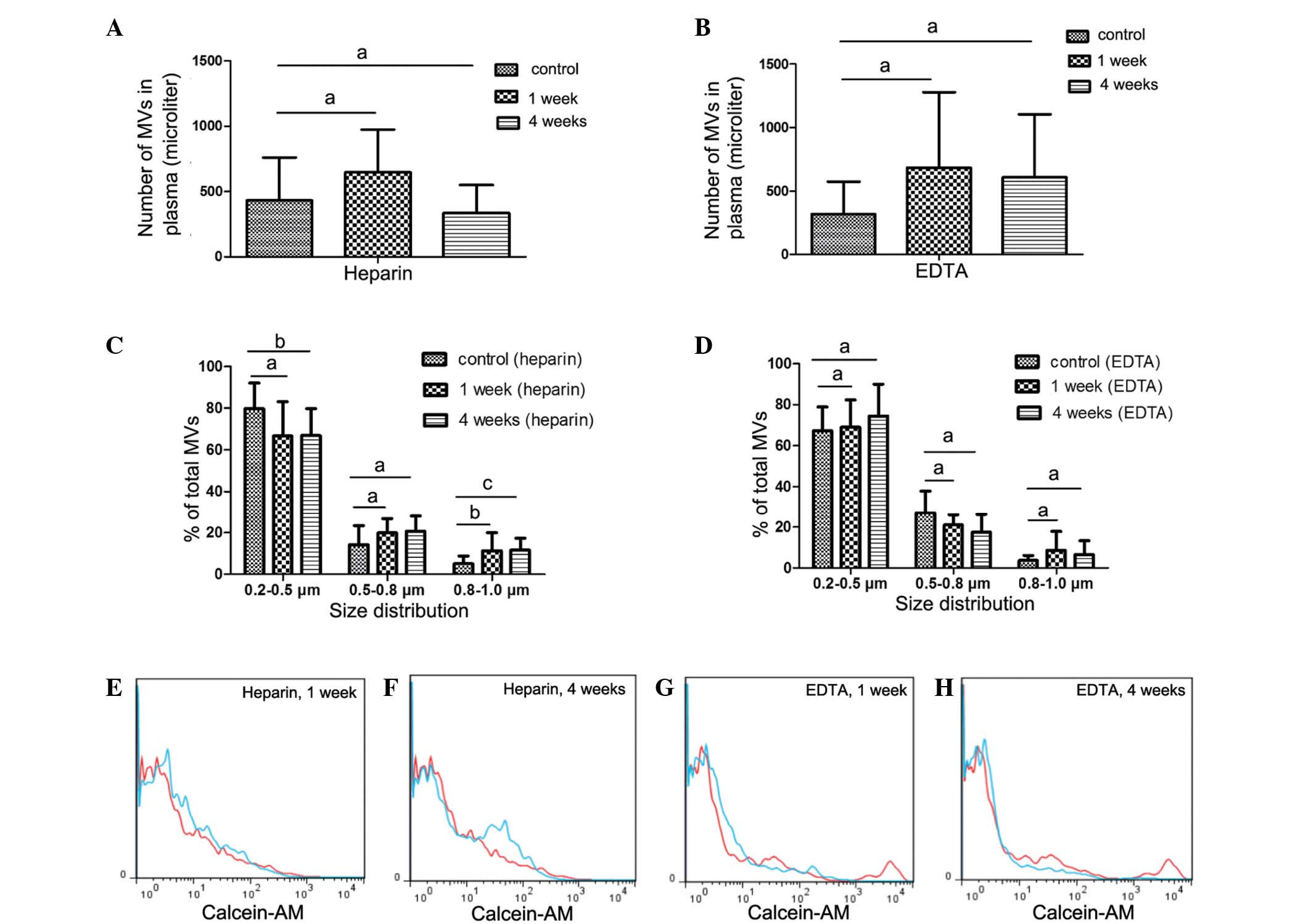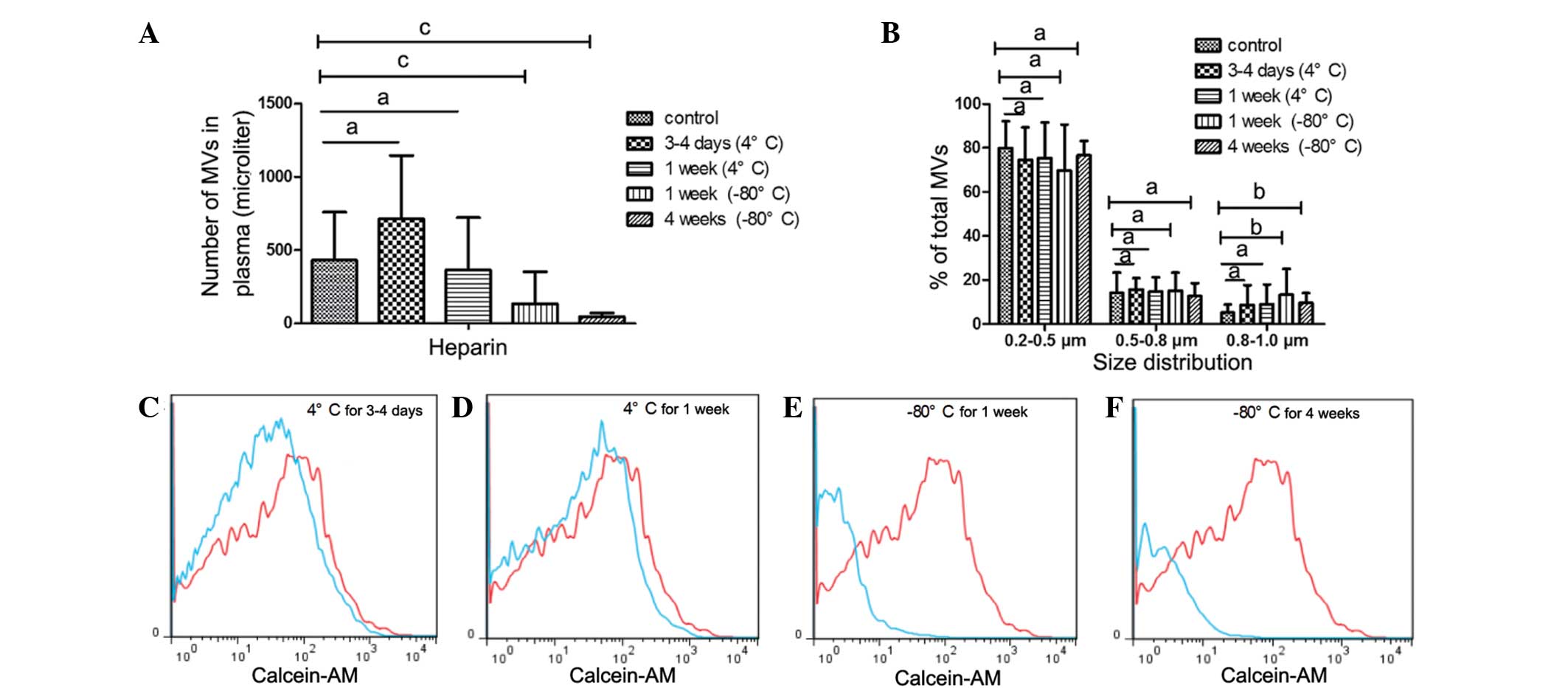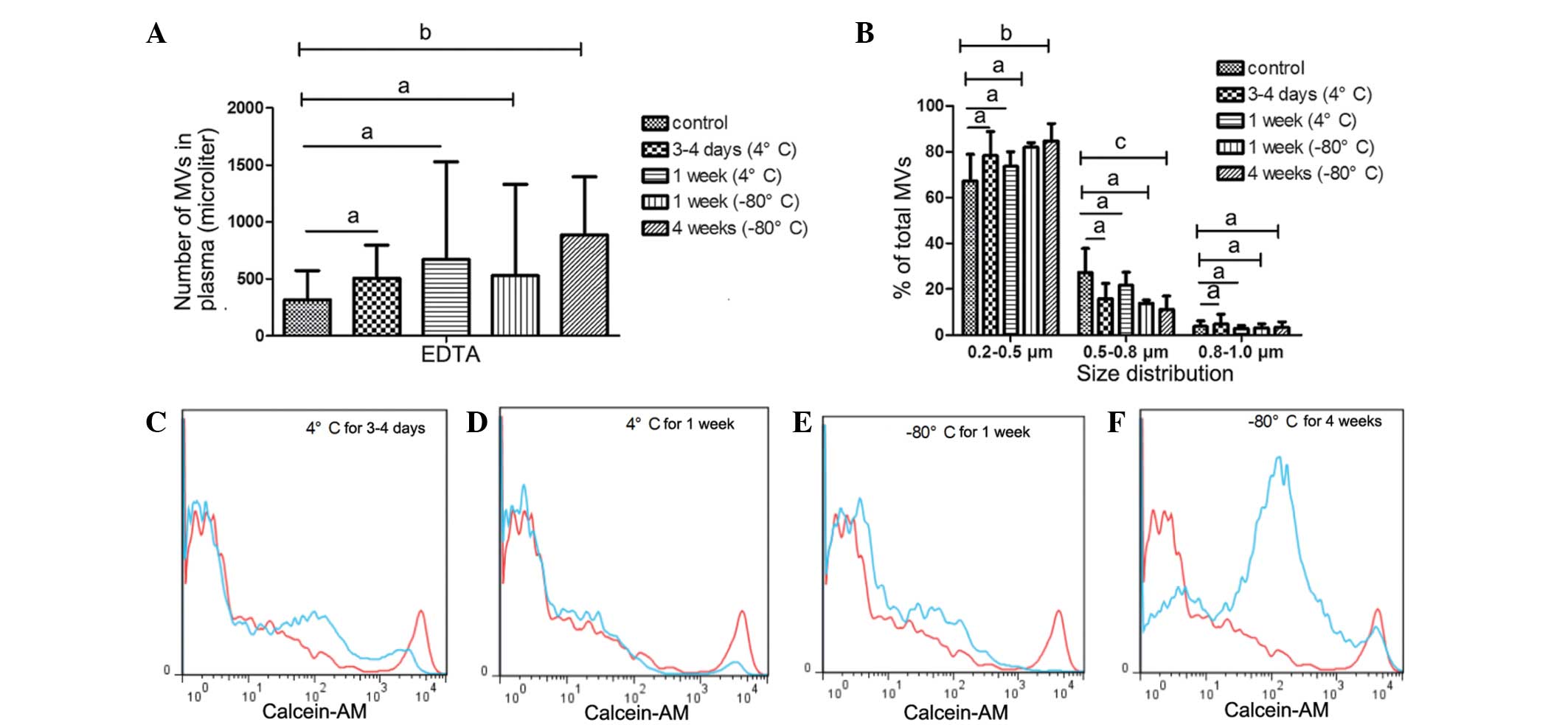|
1
|
Théry C, Ostrowski M and Segura E:
Membrane vesicles as conveyors of immune responses. Nat Rev
Immunol. 9:581–593. 2009. View
Article : Google Scholar : PubMed/NCBI
|
|
2
|
Ashcroft BA, de Sonneville J, Yuana Y,
Osanto S, Bertina R, Kuil ME and Oosterkamp TH: Determination of
the size distribution of blood microparticles directly in plasma
using atomic force microscopy and microfluidics. Biomed
Microdevices. 14:641–649. 2012. View Article : Google Scholar : PubMed/NCBI
|
|
3
|
Dalton AJ: Microvesicles and vesicles of
multivesicular bodies versus ‘virus-like’ particles. J Natl Cancer
Inst. 54:1137–1148. 1975.PubMed/NCBI
|
|
4
|
Keller S, Ridinger J, Rupp AK, Janssen JW
and Altevogt P: Body fluid derived exosomes as a novel template for
clinical diagnostics. J Transl Med. 9:862011. View Article : Google Scholar : PubMed/NCBI
|
|
5
|
Hata T, Murakami K, Nakatani H, Yamamoto
Y, Matsuda T and Aoki N: Isolation of bovine milk-derived
microvesicles carrying mRNAs and microRNAs. Biochem Biophys Res
Commun. 396:528–533. 2010. View Article : Google Scholar : PubMed/NCBI
|
|
6
|
Pisitkun T, Shen RF and Knepper MA:
Identification and proteomic profiling of exosomes in human urine.
Proc Natl Acad Sci USA. 101:13368–13373. 2004. View Article : Google Scholar : PubMed/NCBI
|
|
7
|
Runz S, Keller S, Rupp C, Stoeck A, Issa
Y, Koensgen D, Mustea A, Sehouli J, Kristiansen G and Altevogt P:
Malignant ascites-derived exosomes of ovarian carcinoma patients
contain CD24 and EpCAM. Gynecol Oncol. 107:563–571. 2007.
View Article : Google Scholar : PubMed/NCBI
|
|
8
|
Ghosh AK, Secreto CR, Knox TR, Ding W,
Mukhopadhyay D and Kay NE: Circulating microvesicles in B-cell
chronic lymphocytic leukemia can stimulate marrow stromal cells:
Implications for disease progression. Blood. 115:1755–1764. 2010.
View Article : Google Scholar : PubMed/NCBI
|
|
9
|
Bernal-Mizrachi L, Jy W, Jimenez JJ,
Pastor J, Mauro LM, Horstman LL, de Marchena E and Ahn YS: High
levels of circulating endothelial microparticles in patients with
acute coronary syndromes. Am Heart J. 145:962–970. 2003. View Article : Google Scholar : PubMed/NCBI
|
|
10
|
Sellam J, Proulle V, Jüngel A, Ittah M,
Richard Miceli C, Gottenberg JE, Toti F, Benessiano J, Gay S,
Freyssinet JM and Mariette X: Increased levels of circulating
microparticles in primary Sjögren's syndrome, systemic lupus
erythematosus and rheumatoid arthritis and relation with disease
activity. Arthritis Res Ther. 11:R1562009. View Article : Google Scholar : PubMed/NCBI
|
|
11
|
Toth B, Liebhardt S, Steinig K, Ditsch N,
Rank A, Bauerfeind I, Spannagl M, Friese K and Reininger AJ:
Platelet-derived microparticles and coagulation activation in
breast cancer patients. Thromb Haemost. 100:663–669.
2008.PubMed/NCBI
|
|
12
|
Galindo-Hernandez O, Villegas-Comonfort S,
Candanedo F, González-Vázquez MC, Chavez-Ocana S,
Jimenez-Villanueva X, Sierra-Martinez M and Salazar EP: Elevated
concentration of microvesicles isolated from peripheral blood in
breast cancer patients. Arch Med Res. 44:208–214. 2013. View Article : Google Scholar : PubMed/NCBI
|
|
13
|
Ayers L, Kohler M, Harrison P, Sargent I,
Dragovic R, Schaap M, Nieuwland R, Brooks SA and Ferry B:
Measurement of circulating cell-derived microparticles by flow
cytometry: Sources of variability within the assay. Thromb Res.
127:370–377. 2011. View Article : Google Scholar : PubMed/NCBI
|
|
14
|
Ueba T, Haze T, Sugiyama M, Higuchi M,
Asayama H, Karitani Y, Nishikawa T, Yamashita K, Nagami S, Nakayama
T, et al: Level, distribution and correlates of platelet-derived
microparticles in healthy individuals with special reference to the
metabolic syndrome. Thromb Haemost. 100:280–285. 2008.PubMed/NCBI
|
|
15
|
Jayachandran M, Miller VM, Heit JA and
Owen WG: Methodology for isolation, identification and
characterization of microvesicles in peripheral blood. J Immunol
Methods. 375:207–214. 2012. View Article : Google Scholar : PubMed/NCBI
|
|
16
|
Shah MD, Bergeron AL, Dong JF and López
JA: Flow cytometric measurement of microparticles: Pitfalls and
protocol modifications. Platelets. 19:365–372. 2008. View Article : Google Scholar : PubMed/NCBI
|
|
17
|
Breimo ES and Østerud B: Generation of
tissue factor-rich microparticles in an ex vivo whole blood model.
Blood Coagul Fibrinolysis. 16:399–405. 2005. View Article : Google Scholar : PubMed/NCBI
|
|
18
|
Piersma SR, Broxterman HJ, Kapci M, de
Haas RR, Hoekman K, Verheul HM and Jiménez CR: Proteomics of the
TRAP-induced platelet releasate. J Proteomics. 72:91–109. 2009.
View Article : Google Scholar : PubMed/NCBI
|
|
19
|
Jy W, Horstman LL, Jimenez JJ, Ahn YS,
Biró E, Nieuwland R, Sturk A, Dignat-George F, Sabatier F,
Camoin-Jau L, et al: Measuring circulating cell-derived
microparticles. J Thromb Haemost. 2:1842–1851. 2004. View Article : Google Scholar : PubMed/NCBI
|
|
20
|
Bernimoulin M, Waters EK, Foy M, Steele
BM, Sullivan M, Falet H, Walsh MT, Barteneva N, Geng JG, Hartwig
JH, et al: Differential stimulation of monocytic cells results in
distinct populations of microparticles. J Thromb Haemost.
7:1019–1028. 2009. View Article : Google Scholar : PubMed/NCBI
|
|
21
|
Sun L, Wang HX, Zhu XJ, Wu PH, Chen WQ,
Zou P, Li QB and Chen ZC: Serum deprivation elevates the levels of
microvesicles with different size distributions and selectively
enriched proteins in human myeloma cells in vitro. Acta Pharmacol
Sin. 35:381–393. 2014. View Article : Google Scholar : PubMed/NCBI
|
|
22
|
Shet AS, Aras O, Gupta K, Hass MJ, Rausch
DJ, Saba N, Koopmeiners L, Key NS and Hebbel RP: Sickle blood
contains tissue factor-positive microparticles derived from
endothelial cells and monocytes. Blood. 102:2678–2683. 2003.
View Article : Google Scholar : PubMed/NCBI
|
|
23
|
Jayachandran M, Litwiller RD, Owen WG,
Heit JA, Behrenbeck T, Mulvagh SL, Araoz PA, Budoff MJ, Harman SM
and Miller VM: Characterization of blood borne microparticles as
markers of premature coronary calcification in newly menopausal
women. Am J Physiol Heart Circ Physiol. 295:H931–H938. 2008.
View Article : Google Scholar : PubMed/NCBI
|
|
24
|
Yamada N, Tsujimura N, Kumazaki M,
Shinohara H, Taniguchi K, Nakagawa Y, Naoe T and Akao Y: Colorectal
cancer cell-derived microvesicles containing microRNA-1246 promote
angiogenesis by activating Smad 1/5/8 signaling elicited by PML
down-regulation in endothelial cells. Biochim Biophys Acta.
1839:1256–1272. 2014. View Article : Google Scholar : PubMed/NCBI
|
|
25
|
Zhang W, Zhao P, Xu XL, Cai L, Song ZS,
Cao DY, Tao KS, Zhou WP, Chen ZN and Dou KF: Annexin A2 promotes
the migration and invasion of human hepatocellular carcinoma cells
in vitro by regulating the shedding of CD147-harboring
microvesicles from tumor cells. PLoS One. 8:e672682013. View Article : Google Scholar : PubMed/NCBI
|
|
26
|
Al-Nedawi K, Meehan B, Micallef J, Lhotak
V, May L, Guha A and Rak J: Intercellular transfer of the oncogenic
receptor EGFRvIII by microvesicles derived from tumour cells. Nat
Cell Biol. 10:619–624. 2008. View
Article : Google Scholar : PubMed/NCBI
|
|
27
|
Nielsen CT, Østergaard O, Johnsen C,
Jacobsen S and Heegaard NH: Distinct features of circulating
microparticles and their relationship to clinical manifestations in
systemic lupus erythematosus. Arthritis Rheum. 63:3067–3077. 2011.
View Article : Google Scholar : PubMed/NCBI
|
|
28
|
Joop K, Berckmans RJ, Nieuwland R,
Berkhout J, Romijn FP, Hack CE and Sturk A: Microparticles from
patients with multiple organ dysfunction syndrome and sepsis
support coagulation through multiple mechanisms. Thromb Haemost.
85:810–820. 2001.PubMed/NCBI
|
|
29
|
Banfi G, Salvagno GL and Lippi G: The role
of ethylenediamine tetraacetic acid (EDTA) as in vitro
anticoagulant for diagnostic purposes. Clin Chem Lab Med.
45:565–576. 2007. View Article : Google Scholar : PubMed/NCBI
|
|
30
|
Connor DE, Exner T, Ma DD and Joseph JE:
Detection of the procoagulant activity of microparticle-associated
phosphatidylserine using XACT. Blood Coagul Fibrinolysis.
20:558–564. 2009. View Article : Google Scholar : PubMed/NCBI
|
|
31
|
Yuana Y, Bertina RM and Osanto S:
Pre-analytical and analytical issues in the analysis of blood
microparticles. Thromb Haemost. 105:396–408. 2011. View Article : Google Scholar : PubMed/NCBI
|
|
32
|
György B, Módos K, Pállinger E, Pálóczi K,
Pásztói M, Misják P, Deli MA, Sipos A, Szalai A, Voszka I, et al:
Detection and isolation of cell-derived microparticles are
compromised by protein complexes resulting from shared biophysical
parameters. Blood. 117:e39–e48. 2011. View Article : Google Scholar : PubMed/NCBI
|
|
33
|
Lawrie AS, Albanyan A, Cardigan RA, Mackie
IJ and Harrison P: Microparticle sizing by dynamic light scattering
in fresh-frozen plasma. Vox Sang. 96:206–212. 2009. View Article : Google Scholar : PubMed/NCBI
|















